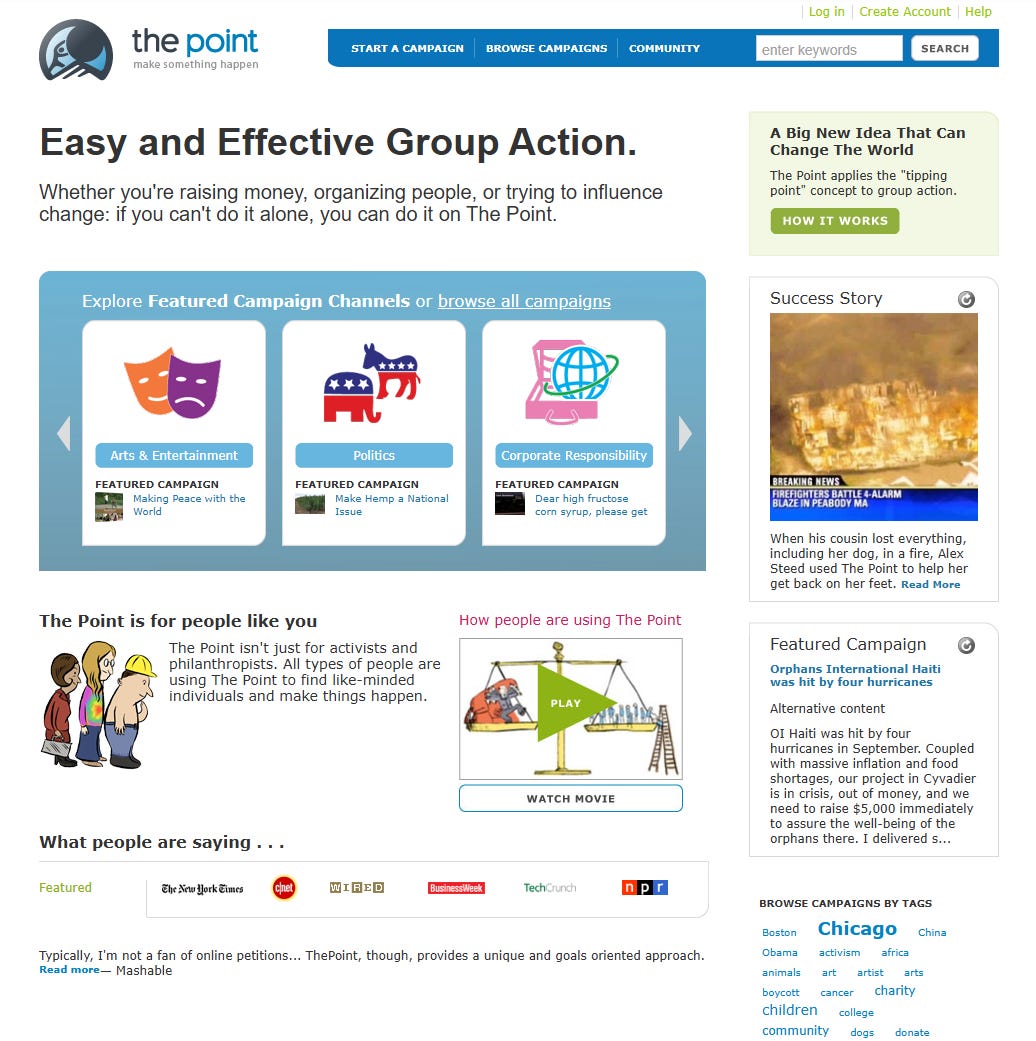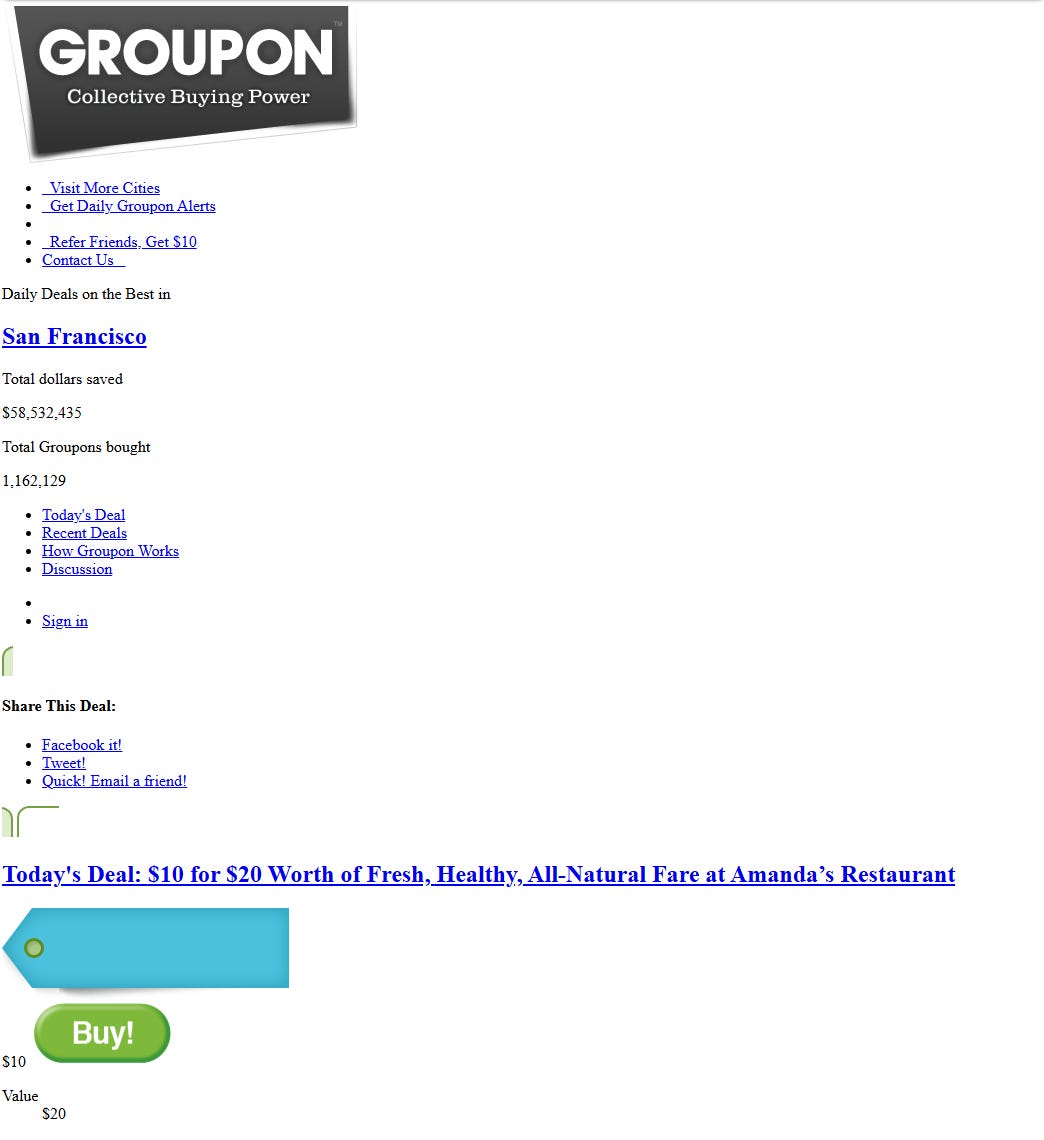The Accidental Business Model
How a Failed Social Movement Platform Became History's Fastest-Growing Company Through One Viral Pizza Deal
You're 26 years old, fresh out of Northwestern University, and you're trying to cancel your damn cell phone contract. (In case you didn’t know, a cell phone contract was a 1–2 year agreement with a mobile carrier in the U.S. If you tried to cancel early, you had to pay a big penalty fee and customer service often made it very hard to quit.) The customer service rep keeps transferring you. The fees are insane. You're getting nowhere, and you're pissed.
Most of us would just rant to our friends and eventually give up. But Andrew Mason? He had a crazy idea that would accidentally create one of the most successful companies in history.
When Life Gives You Cell Phone Problems, Make a Revolution... Or Try To
Mason was fed up with feeling powerless as just one person against these giant corporations. So, he thought, "What if we all banded together? What if frustrated customers could actually fight back by organizing?"
It sounds pretty noble, right? He created this platform called The Point where people could commit to taking action but only if enough others joined them. Want to boycott a company screwing over customers? Sure, but only if 10,000 people agree to do it with you. Want to fund a scholarship? Great, but you need to hit your goal first.
Mason literally created The Point because he had "difficulty terminating his cellular telephone contract." His former boss, Eric Lefkofsky, thought the idea was solid enough to throw $1 million at it in 2007.
The vision was beautiful. The execution? Well, let's just say changing the world is harder than it looks on paper.
Nobody Wants to Be an Activist on Tuesday
Here's the thing about collective action for social causes it sounds great in theory, but most people are too busy living their lives to organize boycotts every week. The Point launched with all this idealistic energy, and then... crickets.
Users would sign up, poke around, maybe commit to a cause if they were feeling particularly motivated that day, but nothing really took off. It was like trying to start a flash mob in a library. Sure, some people were interested, but not enough to create the momentum they needed.
Mason later admitted it was just too abstract. People didn't know what to do with it. Meanwhile, he's sitting there watching his dream of organized consumer activism slowly dying on the internet.
The Plot Twist Nobody Saw Coming
But then something weird started happening. People were using The Point, just not the way Mason intended. Instead of organizing to fight companies, they were organizing to... buy stuff from them.
People were starting "campaigns to get 10 people together to buy something but only to get a discount." Users figured out they could get better deals if they grouped together their purchasing power.
Mason's reaction? "This felt like the dumbest and least inspiring application of the model compared to what we imagined."
Imagine that you're trying to build the next great social movement, and your users just want cheaper dinner. It had to be frustrating as hell.
The Pizza That Changed Everything
Fast forward to 2008. Lefkofsky is breathing down Mason's neck about making money. They've got three options: advertising, taking a cut of fundraising, or this collective buying thing that users seem to actually like.
So, they decided to test it out. They put together "a 500 person email list (of friends, family, and anyone they knew) as their first customers. The first groupon was a 2 for 1 Pizza deal at a bar downstairs in their Chicago office building."
A pizza deal. In the bar below their office. Not exactly the world-changing revolution Mason had dreamed of.
But you know what? It worked. People loved it. Word spread around Chicago like wildfire. Suddenly, local businesses were calling them up, wanting in on this group discount thing.
That's when Mason had his "holy shit" moment. This wasn't about social causes or collective action for the greater good. This was about something much simpler and much more powerful: people getting good deals on stuff they actually wanted
From Zero to Unicorn in Record Time
What happened next was absolutely insane. The Point was dead, but Groupon born from its ashes became "the fastest-growing company in history. Groupon hit a $1 billion valuation in only sixteen months."
Sixteen months. Let that sink in. Facebook took four years to hit a billion. Google took eight years. These kids in Chicago did it in less than a year and a half.
The growth was so crazy that when Google offered them $6 billion yes, billion with a “B” Mason turned them down. Everyone thought he was out of his mind. A two-year-old company run by twenty-somethings rejecting $6 billion? It sounded like pure Silicon Valley arrogance.
But Mason saw something others didn't. He'd accidentally stumbled onto the holy grail of local business: a way to solve customer acquisition problems while giving consumers what they actually wanted.
Sometimes Success Looks Nothing Like Your Plan
Here's what's wild about the Groupon story it's not really about having a brilliant vision. It's about being smart enough to recognize when you're wrong and humble enough to change course.
Mason himself said the path to success was "completely depressing because all you're thinking about is the ways you're about to screw up." This wasn't some confident entrepreneur executing a master plan. This was a guy stumbling around in the dark, paying attention to where his users were actually going.
The market wasn't subtle about what it wanted. Mason's users literally showed him by using his platform in ways he never intended. Instead of fighting that behavior, he followed it.
Lesson for Present Founders and Designers
1. Your Users Are Smarter Than You Think Mason thought he knew what people needed organized social activism. His users showed him what they actually wanted—group discounts. The users were right. They're almost always right about what they'll actually use and pay for.
2. Fall in Love with the Problem, Not Your Solution The real problem Mason was solving? People feeling powerless against big companies. He thought the solution was collective action for causes. It turned out the solution was collective buying power. Same problem, completely different approach.
3. Ego vs. Success: Pick One Most founders would have doubled down on The Point's original mission. "No, no, you don't understand this is about social change, not shopping!" Mason swallowed his ego and followed his users. That decision made him rich.
4. Sometimes Being Inexperienced Is an Advantage Mason had zero entrepreneurial experience. He didn't know you're "supposed to" stick with your original vision no matter what. Sometimes not knowing the rules means you're more likely to break them in useful ways.
5. Watch What They Do, Not What They Say Mason's users didn't fill out surveys requesting a group buying platform. They just started using The Point that way. The best user research sometimes happens organically you just have to be paying attention.
6. Edge Cases Might Be Your Main Use Case Group buying felt like a weird edge case of The Point's collective action model. Turns out it was the main event. Don't dismiss unusual usage patterns too quickly they might be telling you something important.
7. Design for Actual Behavior, Not Ideal Behavior The Point was designed for how Mason thought people should behave organizing for social causes. Groupon was designed for how people actually behave looking for good deals. Guess which one worked?
8. Iteration Is Everything The Point wasn't a failure it was expensive user research. It taught Mason everything he needed to know to build Groupon. Sometimes your first version's job is just to help you understand what your second version should be.
9. User Intent Is King Mason's original intent was social activism. His users' intent was saving money on dinner. User intent won, and everyone including Mason—was better off for it.
Why Most People Get This Wrong
Most entrepreneurs are like parents who insist their kid should be a doctor when the kid clearly wants to be an artist. They fall in love with their original idea and refuse to let it grow into what it wants to become.
Mason could have been that founder. He could have kept pushing The Point, trying to make people care more about collective social action. He could have seen the group buying behavior as a distraction from his "real" vision.
Instead, he did something much harder: he listened. He watched what his users were actually doing instead of what he thought they should be doing. He followed their energy instead of fighting it.
The Plot Twist Ending
Here's the kicker Groupon eventually ran into its own problems. The business model had issues, competition got fierce, and the stock price crashed. But that's not really the point of this story.
The point is that sometimes the most important thing you can do as a founder is get out of your own way. Your job isn't to force users to want what you think they should want. Your job is to figure out what they actually want and give it to them.
Mason's users were trying to tell him something from day one. They didn't want to organize boycotts they wanted to organize purchases. They weren't looking for social revolution they were looking for dinner deals.
The smartest thing he ever did was listen.
The Bottom Line for Every Founder and Designer
Your original idea probably isn't your best idea. Your users will try to tell you what they actually want, but they won't always use words. Sometimes they'll show you by using your product in ways you never intended.
Pay attention to that. It might feel like failure when people don't use your product the way you envisioned. But sometimes "failure" is just the market trying to teach you something valuable.
The Point failed because it was solving a problem people didn't have or at least, not one they cared enough to act on. Groupon succeeded because it solved a problem that both consumers and businesses desperately wanted solved.
The difference between the two? Mason was smart enough to notice when his users were trying to teach him something, and humble enough to be their student instead of their teacher.
Sometimes the best thing you can do for your product is let it become what it wants to be, not what you think it should be.






